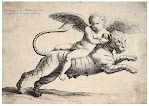
There had been a storm with heavy rain before dawn last Wednesday, and it was still drizzling when I got to the park around 6:00 a.m. The air was warm and the trail was a soggy mess, which made conditions perfect for the box turtles. I came across one every fifty yards or so, and they were all moving along at a pretty brisk pace by turtle standards, heads up, looking alert.
I was really enjoying the turtle parade, thinking how nice it was to see so many emerge at once, and then I came across the star-crossed lovers. Boy had succeeded in meeting girl, but something had gone haywire with the consummation. Normally, the male mounts and enters the female from behind, and hooks his rear claws into the edge her shell. Sometimes he flips over on his back, which looks like
this. They can stay that way for hours.
The necessary contortions of love seem a little challenging for a turtle under the best circumstances, but this particular pair had failed completely. When I found them, the female was on her back, completely withdrawn into her shell, and the male was upright with one foot hooked into her leg opening--on the wrong side, no less. Worse yet, they had fallen down into a little crevice along the side of the trail, and were wedged next a 2 X 4 that had been pushed into the hillside as a support.
I’m not sure whether the trouble was male incompetence or female recalcitrance—probably a bit of both. In any case, things weren’t looking good for baby turtle production, and I wasn’t entirely sure they would be able to get themselves out of their predicament. The male’s foot was twisted at such an odd angle I wondered if he could let go even if he wanted to, and it seemed unlikely that the female could right herself if he remained attached.
So, with some reservations about violating
the Prime Directive, I picked them up as a unit and set them down on the path. I gently prodded the male’s foot, trying to get him to release the female, but he hung on tight and didn’t even retreat into his shell. He had found his woman, and he was damn well going to keep hold of her. There were at least two other males nearby ready to move in if he surrendered the field, so I suppose his determination was understandable.
Hoping they’d work things out on their own, I moved about 10 feet away, to a spot where neither of them could see me. And waited. A long time. He didn’t budge a millimeter. She never made any attempt to turn over, or even poke her head out. As I stood there, it dawned on me that a) it was still raining and I was getting extremely wet; and b) if turtles can fuck for hours, there was no reason to think they’d be in any particular hurry to abandon a troubled attempt.
So I gave up and went home, feeling stupid for interfering, but also frustrated that I lacked the patience necessary to witness the resolution. Did she finally relent and give him a second chance? Did he give up and let his competition take over? Whatever happened, the uncooperative female survived it just fine. I recognized her unique shell markings when I saw her at the same spot on the trail yesterday. She was calmly munching on some delicacy she'd found in the leaf litter. Her determined boyfriend was nowhere in sight.
Illustration by John Edwards Holbrook, 1842. Image from
Wikimedia Commons.





























.jpg)














.jpg)



